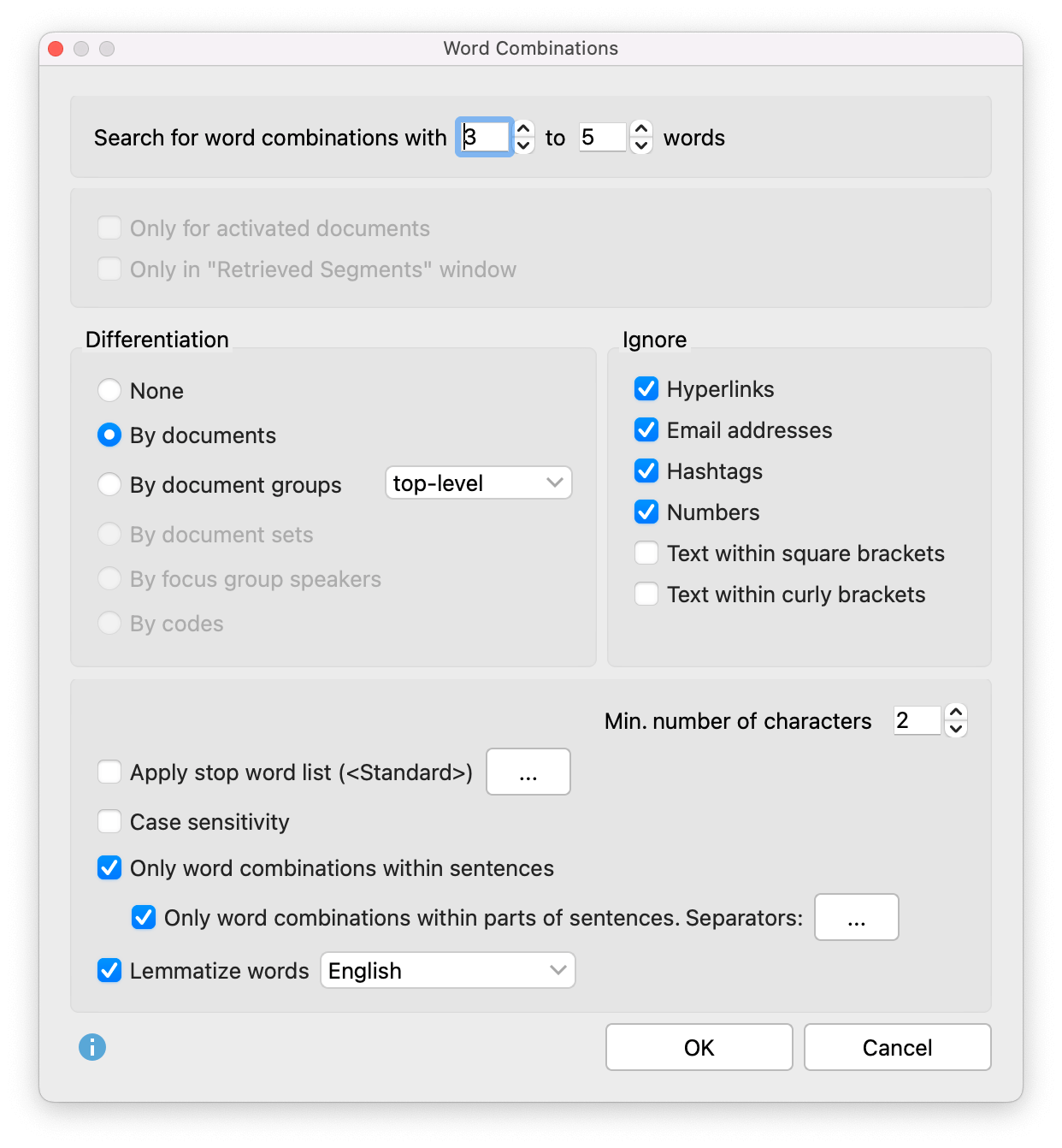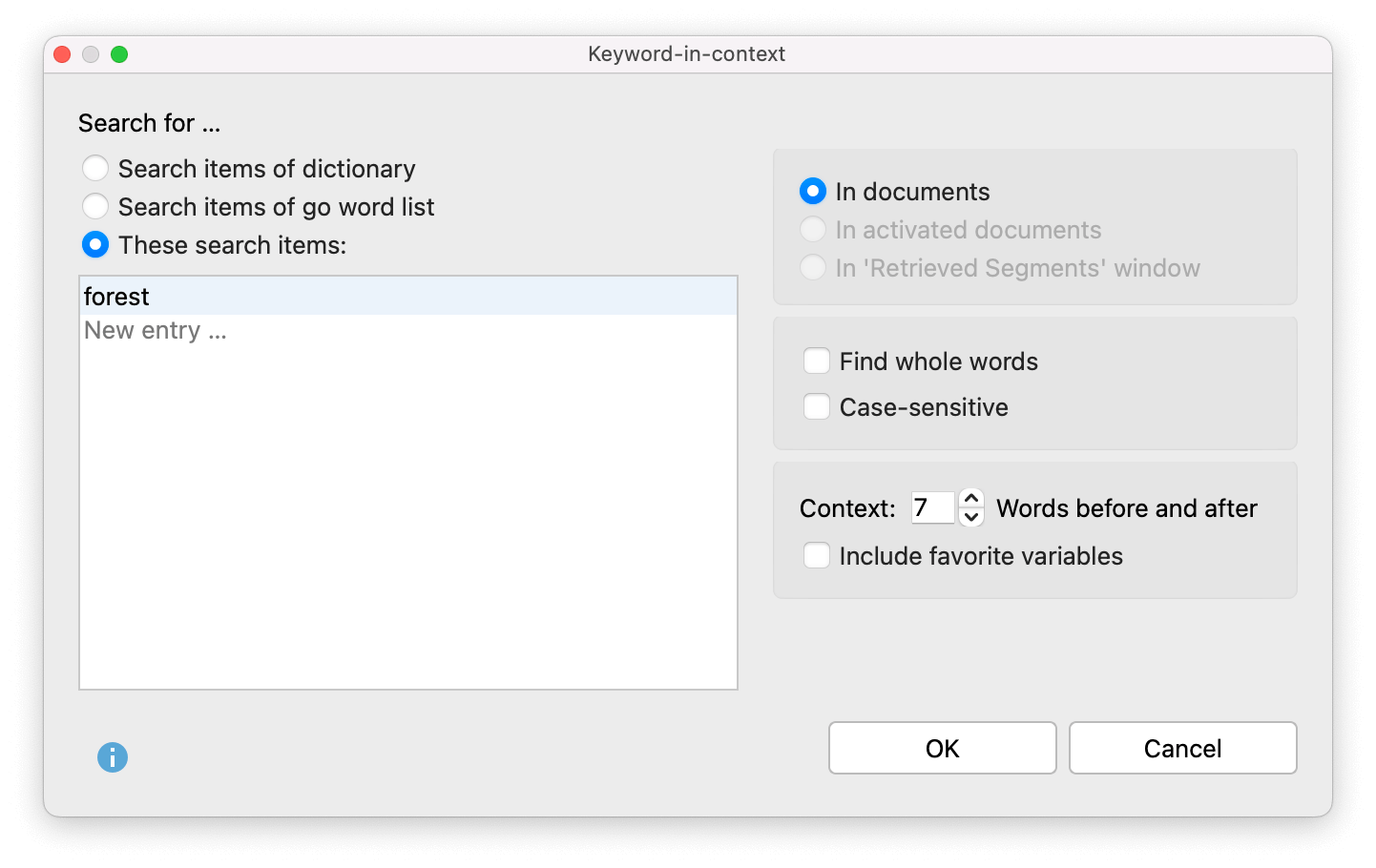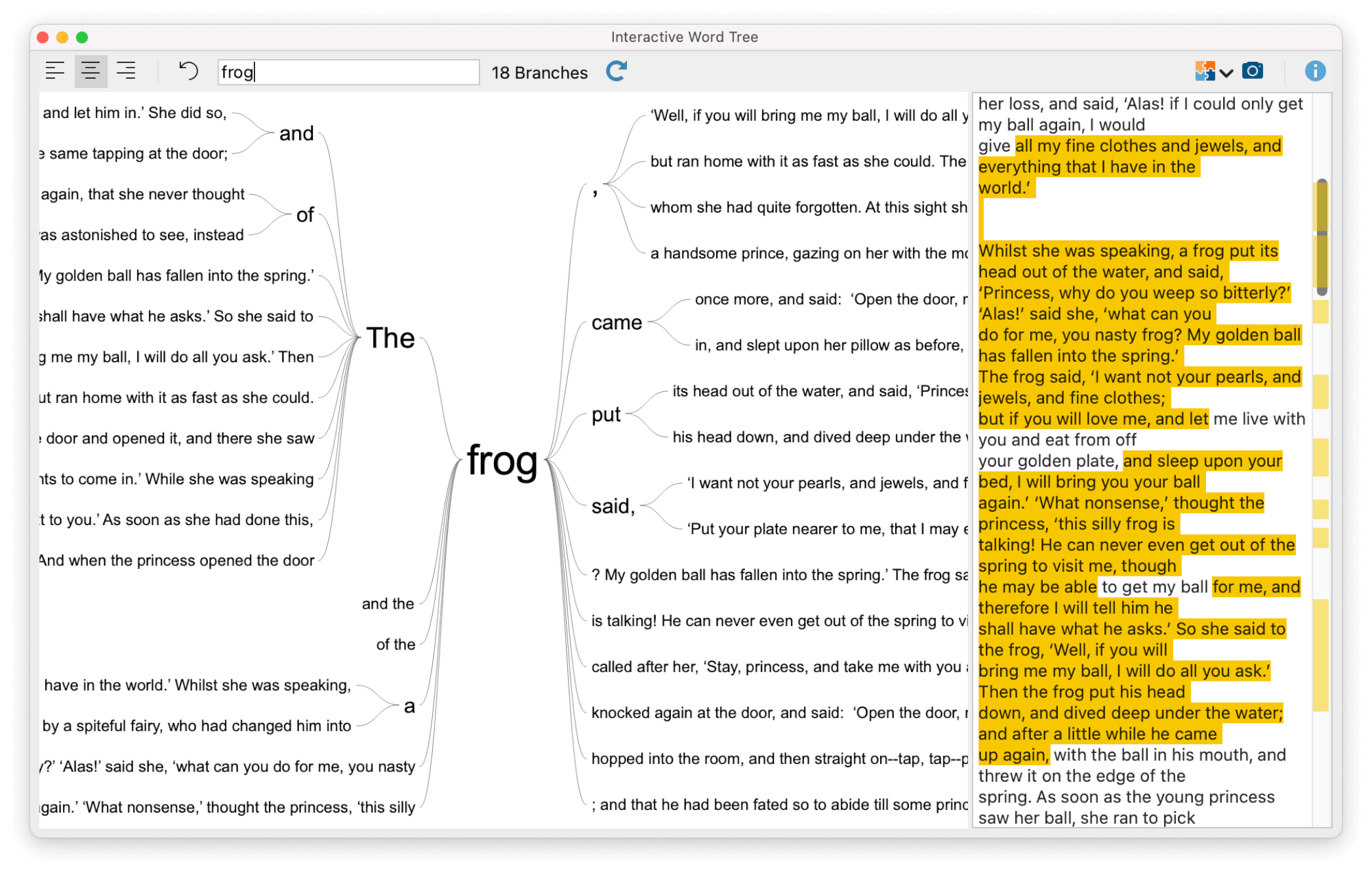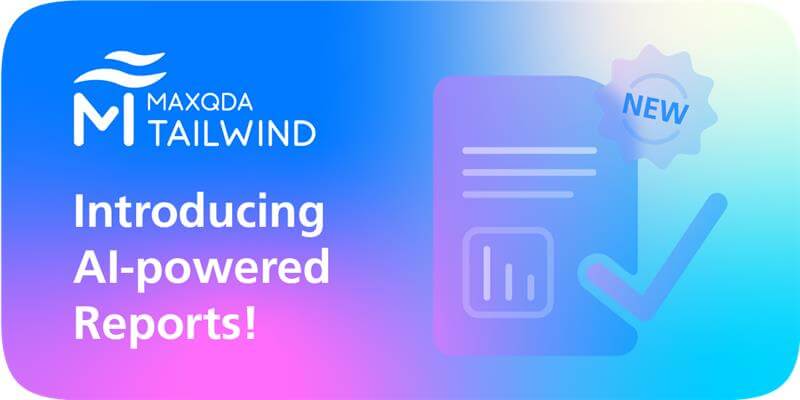
Qualitative Content Analysis is an important research tool in many scientific disciplines – encompassing many different approaches and techniques. Researchers use content analysis to determine and analyze the presence, meanings, and relationships of words, word combinations, concepts, and themes. In this month’s blog, we will focus on one aspect of content analysis, namely the word combination analysis and how you can perform one with MAXQDA.
Motivation for analyzing word combinations
Analyzing the frequencies and distribution of individual words across our data can help us to identify a text’s general topic and sentiment. Frequently used words denote important concepts discussed in the text, and negatively connotated words most likely reflect a negative sentiment towards the topic. However, if we want to dive deeper and understand the relationship between words, it is useful to move beyond analyzing single words. This can be accomplished by conducting a word combination analysis.
Investigating what sequences of words are common across our data can give valuable insights about how the language is used. For example, recurring patterns of language – so recurring word combinations – reflect fundamental properties of language, such as the language’s complexity, language competence, and general style. Using word combination analyses, researchers can for example compare the complexity of language used in different newspapers.
Furthermore, we can use a word combination analysis to deepen our understanding of single terms or concepts. Exploring what words are most likely to precede or follow your term of interest, can give valuable insights about the context and sentiment towards the analyzed term. For example, whether a positively connotated word really reflects a person’s positive attitude towards a topic, or whether it is used ironically can only be determined when considering the word’s context.
Use MAXQDA for your Word Combination Analysis
As the #1 software for qualitative and mixed methods data analysis, MAXQDA offers a variety of tools for a word combination analysis, some of which we will present in this article. Especially, the tools of MAXDictio – MAXQDA’s add-on module with advanced features for quantitative content analysis – are valuable for a word combination analysis. In addition, we will present the new Word Explorer and the Word Cloud which can visualize not only the most common single words but also the most common word combinations.

Tools in the MAXDictio Tab
Tip: MAXDictio is the add-on module that comes with the MAXQDA Plus license. It offers a vast range of procedures for quantitative content analysis, such as the analysis of word combinations.
Learn more about MAXDictioExploring word combinations in fairy tales
As an exemplary data set to analyze word combinations, we will use Grimms’ Fairy Tales. Grimms’ Fairy Tales are a collection of German fairy tales published by Jacob and Wilhelm Grimm between 1812-1858. Fairy tales are characterized by a distinctive language and typical word combinations. The word combination “Once upon a time” is a perfect example of a typical word combination in fairy tales. We will focus on four of the most popular Grimms’ fairy tales, namely: Hansel and Gretel, Rapunzel, The Frog Prince, and the Valiant Little Tailor.

Title page of first volume of Grimms’ Children’s and Household Tales (1819) 2nd Ed.
Do you want to read the fairy tales? You can find the entire collection of Grimms’ fairy tales here:
Read fairy talesTools perfectly suited to analyze word combinations
The clue is in the name: MAXQDA’s Word Combinations tool

Word Combinations tool in the MAXDictio tab
Are you interested in analyzing the frequencies, ranks, and distribution of word combinations? Then MAXDictio’s Word Combinations tool is perfectly suited for you. Using the Word Combinations tools, we quickly get an overview of the most frequent word combinations and can easily compare them between texts. The settings dialogue offers many options to adjust the word combination analysis to your needs, such as applying lemmatization (summarizing words that share the same stem) and stop word lists (to obtain more meaningful results). Of course, you can define the number of words the word combination consists of.

Word Combinations settings window
The Word Combination analysis results are presented as a table, as default ordered by frequencies (descending). When analyzing word combinations in several documents at once, you can differentiate the results by document. In this case, the result table consists of a separate column for each document containing the respective frequencies. By clicking on the column’s header (the document’s name), you can order the word combinations according to their frequency in this fairy tale. By double-clicking on an entry in the word combination column, you get a list containing all occurrences of the clicked word combination, the context, as well as its position in the texts. In many cases, the Word Combinations tool is a good starting point for your word combination analysis, because the overview table enables you to quickly draw first inferences, such as identifying keywords and word combinations that might be worth taking a closer look at.

Word Combinations Results
Word Combinations in Grimm’s Fairy Tales
Regarding the analysis of Grimm’s fairytales, the word combination “the little tailor” is by far the most frequent one with 22 occurrences – although this word combination occurs in only 1 of the analyzed fairy tales (see the column “Documents”). Apparently, the main character is not addressed by name throughout the fairy tale. Instead, the main character is described by his profession and the adjective “little”. This is interesting because during the course of the story the main character has to fight giants. By repeatedly using the word combination “the little tailor” inferiority, especially compared to the giants, is created which makes the fairy tale more exciting.

The valiant little tailor provokes the giants
Interestingly, quite a few of the most frequent word combinations include the word “forest” (e.g. “into the forest”, “the forest and”, “in the forest”, “of the forest”). When looking at the frequencies per fairy tale it becomes evident that 3 out of 4 Grimms’ fairy tales take place (at least partly) in a forest, suggesting that “forest” is a recurring topic in Grimm’s fairy tales which might be worth to investigate further.
Visually present the most frequent word combinations
The Word Combination’s result table enables you to get a quick overview and easily compare occurrences between documents. However, for a publication or a poster the table might look a bit boring. To present your word combination analysis results in a visually more appealing way, you can create Word Clouds for word combinations with just one click. Simply click on the word cloud icon in the toolbar of the results table to create a Word Cloud for the result table. As almost always in MAXQDA, the visualization is interactive: clicking on a word combination opens a table containing all occurrences.

Word Cloud for Word Combination Analysis
If you want to create a separate word cloud for each fairy tale, simply perform the Word Combination analysis for each document individually. Below you can find screenshots of Word Clouds that were created for each fairy tale separately. As you can see, the fairy tales use quite distinctive word combinations. If you are familiar with the stories, you probably immediately see which word cloud belongs to which fairy tale. Even when excluding the characters’ names (by transferring the character names to the stop word list), you can easily match the Word Cloud to its corresponding fairy tale. Thus, word clouds can be used to quickly identify whether there is a qualitative difference concerning word combinations.



Word Clouds for Word Combinations separated by fairy tale
Keyword-in-context: Define word and number of context words for word combination analysis

Keyword-in-context tool in the MAXDictio tab
Another tool that is very valuable for a Word Combination Analysis is the Keyword-in-context tool which is also part of the MAXDictio add-on module. The Keyword-in-context tool allows you to search for relevant terms, but most importantly, it shows them within their context. This is particularly useful when you want to delve deeper into the context of words, for example, to find out how a keyword is used in different texts. You can freely define the number of contexts words and even include Document Variables.

Keyword-in-context settings
Concerning the word combinations analysis of Grimms’ fairy tales, we found that the term “forest” is included in some of the most frequent word combinations. Therefore, it might be interesting to delve deeper into the word’s context to find out if the word “forest” has the same appeal throughout Grimm’s fairy tales. To do so, we simply added “forest” to the Search term list, defined the context (7 words before/after), and clicked Ok. As for the Word Combinations tool, the results are presented as a table containing the text passage’s position, the preceding words, the keyword, and the subsequent words. As always, the table is interactive: Clicking on an entry highlights and jumps to the corresponding text passage in the Document Browser.

Keyword-in-context results for the word ‘forest’
When going through the results table to compare the text passages between fairy tales, it becomes evident that the term “forest” does not have the same appeal across fairy tales. While in Hansel and Gretel the forest carries a negative connotation, in Rapunzel the forest is the Prince’s place of desire. In the Valiant Little Tailor the forest is presented as a mysterious place, where giants and unicorns live. In more detail: In Hansel and Gretel, the forest is presented as a dark and dangerous place of which the children are afraid. This is illustrated for example in: “to leave my children alone in the forest? — the wild animals would soon come”, or “they did not get out of the forest, and were very hungry”. By contrast, in Rapunzel the forest occurs less frequently and the word’s context is more positive as in Hansel and Gretel, e.g. “every day he went out into the forest and listened to it”. The prince voluntarily visits the forest, because this is where Rapunzel lives, while Hansel and Gretel were brought into the forest involuntarily.
Interactive Word Tree: Use branches for word combination analysis

Interactive Word Tree tool in the MAXDictio tab
The Interactive Word Tree is another excellent tool for a word combination analysis. It is a visually supported form of the keyword-in-context analysis that allows you to explore and analyze word combinations in their respective context. The tool visualizes word combinations as a tree, making it easy to explore its individual branches. When you open the Word Tree tool the most frequent word is displayed as the root. Words that follow (or precede) are connected to the root via branches. You can either click on a word to add it to the word combination and visually explore its context or you search for specific word combinations by typing them in the search field at the top. In addition, you can decide if you are interested in the text that follows, the text that precedes, or both. In the Word Tree we don’t just see words in context, but word frequencies as well. The word’s frequency will appear in the tooltip when hovering over the word.

Interactive Word Tree of the Frog prince
Word Explorer: Analyze single words or phrases including their most frequent word combinations

Word Explorer in the Analysis tab
The Word Explorer is one of the new tools of MAXQDA 2022. Using an interactive dashboard, the Word Explorer presents various aspects of how and when a term or phrase is used in your material as well as in your writing. Besides exploring the word’s occurrences, the tool allows you to identify the words with which the search word is most frequently combined. Just type in a search word and click “Explore”. But that’s not all: The tool is not limited to analyzing single words, you can also use word combinations as a search term. This is particularly useful if you are interested in specific word combinations a priori. Because the elements are interactive you can easily jump from the dashboard to view the sources or complete frequency lists. Of course, the Word Explorer offers, stop word lists, lemmatization and so on that allow you to refine your word combination analysis.


Comparison of the words “king” and “queen” using the Word Explorer
Comparing “king” and “queen” using the Word Explorer
Queen, king, prince, and princess are typical figures in fairy tales. Therefore, I wanted to explore how and when these terms are used, including the most frequent word combinations. As you can see in the screenshot above, a king is mentioned in all of the analyzed fairy tales, while a queen occurs only once in the The Valiant Little Tailor. This reflects an imbalance between female and male figures of power in Grimm’s fairy tales. When looking at the most frequent word combination section, we can see that even in the one occurrence of the word “queen” the king is mentioned as well (“queen heard her husband”). By comparison, the word king is most frequently combined as “the king’s son” which also describes a male person of power. Thus, it becomes evident that the king is considered as more important than the queen, which reflects the patriarchal structure of the monarchy during that time.
Conclusion
Expanding you research by conducting a word combination analysis can be very valuable. Using MAXQDA for your word combination analysis enables you to find connections between words that you probably did not expect. In addition, word combination analysis can be used to deepen our understanding of single terms or concepts. With word combination analysis you can tackle many different research questions, and MAXQDA allows you to do so using many different file formats. If you want to get started with your own word combination analysis, you might be interested in upgrading your MAXQDA Standard license to MAXQDA Plus
If you want to learn more about word-based analyses in MAXQDA then this tutorial might be interesting for you:
Are you interested in other methods for analyzing qualitative data? Then the following blog articles might be interesting for you.




